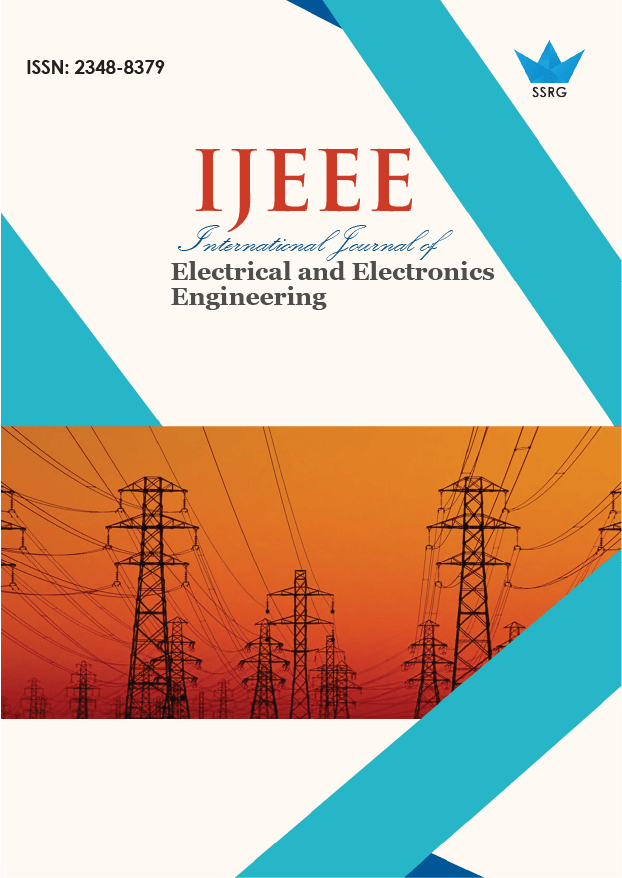Improved Method for Modeling the Universal High Impedance Arcing Faults with RLC Circuit in MATLAB/Simulink®

| International Journal of Electrical and Electronics Engineering |
| © 2020 by SSRG - IJEEE Journal |
| Volume 7 Issue 2 |
| Year of Publication : 2020 |
| Authors : Muzamil Faiz, Abdul Qadir Chang, Agha Zafar Ullah pathan, Amna Fayyaz Chaudhary |
How to Cite?
Muzamil Faiz, Abdul Qadir Chang, Agha Zafar Ullah pathan, Amna Fayyaz Chaudhary, "Improved Method for Modeling the Universal High Impedance Arcing Faults with RLC Circuit in MATLAB/Simulink®," SSRG International Journal of Electrical and Electronics Engineering, vol. 7, no. 2, pp. 23-28, 2020. Crossref, https://doi.org/10.14445/23488379/IJEEE-V7I2P105
Abstract:
High impedance (HiZ) fault is an unwanted operating condition of Power Distribution Companies (PDCs) which rarely effect the continuity of supply but poses a potential electrocution hazards for human beings and animals and fire hazards for public assets. Detection of HiZ faults with 100 % accuracy still needs improvement in existing algorithms and methods. In this paper different HiZ arc model techniques are reviewed and a modified arcing model is proposed, modeled in MATLAB/Simulink and the results show that proposed method is reliable for modeling arcing based HiZ faults.
Keywords:
High impedance faults, Arc model, Simulation, Public safety, PDS, PDCs.
References:
[1] Sharaf, A.M., and S.I, Abu-azab. “ A smart relaying scheme for high impedance faults in distribution and utilization networks” Electrical and Computer Engineering, 2000 Canadian Conference on Vol.2. IEEE-2000.
[2] S.R. Nam, J. K. Park, Y.C. Kang, and T.H Kim, “ A modeling method of high impedance fault in a distribution system using two series time varying resistances in EMTP,” presented at proceeding of Power Engineering Society Summer Meeting, 15-19 July 2001. Vancouver, BC, Canada, 2001.
[3] Nagy Elkalashy, A.M.I. Taalab, “ Modeling and experimental verification of high impedance arcing faults in medium voltage networks,” IEEE transaction on Dielectrics and Electrical insulation, May 2007.
[4] J.C. Chen, B.T. Phung, D.M. Zhang, T. Blackburn & E. Ambikairajah, “ Study on high impedance fault arcing current charactrestics,” Australasian Univeristies Power Engineering conference, AUPEC-september,2013.
[5] Emamanuel A, Cyganski D, Orr JA, “ High impedance fault on sandy soil in 15 kV distribution feeders,” contribution to the evaluation of the low frequuency spectrum, IEEE Trans Power Delivery April 1990; 5(2)” 673-86.
[6] David Chan Tat and Y.Xia, “ A novel technique for high impedance fault identification, “ IEEE Trans on Power delivery, Vol 13, pp. 738-44,07/1998.
[7] S. Yong, and S.M. Rovnyak, “ Decision tree-based methodlogy for high impedance fault detection,” IEEE Trans. On Power delivery, vol. 19, pp. 533-6, Apr. 2004.
[8] Emamanuel A, Cyganski D, Orr JA, “ High impedance fault on sandy soil in 15 kV distribution feeders,” contribution to the evaluation of the low frequuency spectrum, IEEE Trans Power Delivery April 1990; 5(2)” 673-86.
[9] Jinmi Gregory Lezama Calvo, Patrick Shweitzer, Serge Weber, Patrice Joyeux, “ Appliances modelling and simulation: A virtual platform applied for arc fault testing” Conference paper 2018.
[10] James Stewart ,”Calculus: Early Transcendentals 8th Ed.”
[11] Mathworks, “ Accelerating the pace of Engineering and Science, http://www.mathworks.com/products/simpower/(20.8.2015)
[12] Chun Sing Lai, “ High impedance fault and heavy load under big data context,” IEEE international conference on system, man and cybernetics, 2015.
[13] “ IEEE guide for measuring earth resistivity, ground impedances and earth surface potentials of a ground system” Std 81-1983, 1983.

 10.14445/23488379/IJEEE-V7I2P105
10.14445/23488379/IJEEE-V7I2P105